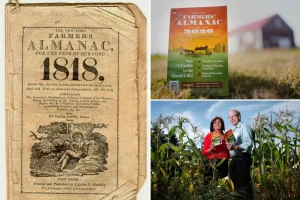The Farmers’ Almanac: A Cherished American Tradition Comes to an End
After more than two centuries of guiding Americans through changing seasons and offering homespun wisdom, the Farmers’ Almanac will cease publication following its 2026 edition. This beloved institution, which has weathered countless societal transformations since its 1818 debut, has finally succumbed to the financial challenges of the modern publishing landscape. “It was a very, very tough decision,” editor Sandi Duncan told The Washington Post, her voice reflecting the gravity of ending a tradition that has outlasted wars, technological revolutions, and cultural upheavals. The announcement has prompted an outpouring of nostalgia from devoted readers who viewed the publication as more than just a periodical—it was a tangible connection to America’s agrarian roots and simpler times.
The Farmers’ Almanac emerged during James Monroe’s presidency, when America was predominantly rural and agricultural knowledge was essential for survival. With a population under 10 million and the Civil War still decades away, the country was unrecognizable compared to today. Yet through every major historical turning point, the Almanac remained steadfast, offering its signature blend of weather predictions, farming tips, and folksy advice. One of its most remarkable caretakers was Ray Geiger, who edited the Almanac for an astounding 60 years, even sending content to his sister for publication while he served in World War II. Under his leadership, the Almanac expanded its reach significantly, with Geiger appearing on popular television shows like David Letterman and traveling extensively to promote the publication. His dedication exemplified how the Almanac was always more than a job—it was a mission to preserve a piece of American heritage.
Perhaps nothing about the Farmers’ Almanac has generated more intrigue or controversy than its famous long-range weather forecasts. Based on a closely guarded formula involving sunspots, planetary positions, and lunar cycles, these predictions have fascinated generations of readers. “Our founding editor came up with correlations between what was happening in the sky with what was happening with the weather,” Duncan explained, describing it as a “mathematical and astronomical formula.” The identity of the current forecaster, who goes by the pseudonym Caleb Weatherbee, remains a well-kept secret even as the publication prepares to close its doors. While devotees claim an accuracy rate of around 80%, skeptics—including professional meteorologists—dismiss the predictions as little more than guesswork. Nevertheless, Duncan proudly points to several historical occasions when the Almanac correctly forecast important weather events, including predictions for President Nixon’s daughter Tricia’s Rose Garden wedding in 1971, Arnold Schwarzenegger and Maria Shriver’s wedding in 1986, and even Barack Obama’s open-air speech in Denver in 2008.
When Duncan began her career at the Almanac’s office in Lewiston, Maine, in August 1991—coincidentally on the same day Hurricane Bob struck the state—she could not have foreseen how dramatically the publishing landscape would change. Under her stewardship, the Almanac navigated the digital revolution while maintaining its traditional appeal, reporting a circulation of 2.1 million throughout North America by 2017. Surprisingly, in recent years, the publication experienced a surge in interest from younger generations seeking simplicity and self-sufficiency in an increasingly complex world. “I think for the past five to 10 years, there’s been a younger generation that’s looking to live a little bit more simply,” Duncan observed. This trend accelerated during the COVID-19 pandemic, as people confined to their homes turned to the Almanac for guidance on gardening and food production. However, the digital transition that expanded the Almanac’s reach paradoxically undermined its financial viability. “We share all this stuff online for free because we want to, but it’s for free. How do you pay to keep the lights on?” Duncan lamented, identifying the same challenge that has decimated newspapers across the country.
The announcement of the Almanac’s closure prompted an emotional response from its 1.4 million Facebook followers, many of whom shared personal stories about what the publication meant to them. “Sad to see something with such heritage leaving,” one reader commented. “Soon there will be nothing left.” Another wrote poignantly, “Thank you for being part of my life for decades. Every year, I would rejoice and buy the Almanac to both devour and savor.” These tributes speak to how deeply the Almanac had woven itself into the fabric of American life. As one reader eloquently put it, “The Almanac saw us through 4-5 major wars, innumerable skirmishes, the Great Depression, several recessions…and the good times, the bountiful times, the caring and loving times. The interstate highway system, the moon landing. The Farmers’ Almanac, like National Geographic, became an institution unto itself. Always there. Always reliable. Always honest. Always counted on.”
The closure affects five full-time employees and a team of dedicated freelancers who viewed their work as more than just a job. For Duncan, the end of this chapter brings uncertainty but also new possibilities. With characteristic humor, she noted that she’ll now “have more time to do some gardening”—a fitting next step for someone who has spent decades helping others cultivate their own gardens, both literally and metaphorically. While the physical publication may be ending, Duncan hopes “the Almanac meant so much to so many people that its spirit will live on forever.” Indeed, in a nation that has transformed beyond recognition since the Almanac’s founding, the values it championed—connection to the natural world, self-reliance, community wisdom, and a touch of whimsy—remain as relevant as ever. As Americans continue to navigate an uncertain future, the Farmers’ Almanac’s enduring legacy reminds us that some traditions, even when they formally end, leave an indelible imprint on our collective consciousness.



